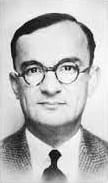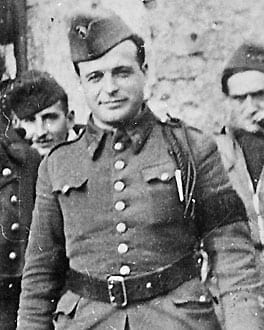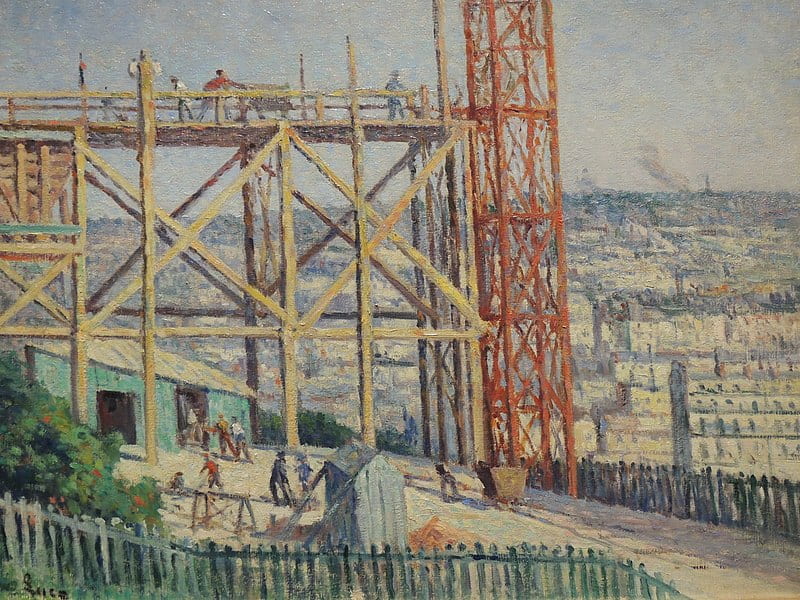By Dustin M. Taylor
In February 1939, the Société Française de philosophie organized a discussion in Paris between two young philosophers who had both recently defended their dissertations. These two philosophers were Jean Cavaillès (1903-1944) and Albert Lautman (1908-1944). The subject of their discussion was the foundations, or life [la vie] of mathematics, a popular and controversial topic amongst philosophers and mathematicians at the turn of the 20th century. The simultaneously clairvoyant and obscure nature of that debate was representative of the two thinkers’ lives. Intellectual rivals and good friends, Cavaillès and Lautman were original and passionate thinkers of the primordial reality of mathematical experience; however, both men had their bright careers cut short. In 1944, following their respective arrests for being members of the French resistance, both men were executed by Nazis.
Both Cavaillès and Lautman trained with the tragically forgotten philosopher and historian, Léon Brunschvicg (1869-1944), who assisted in organizing their debate. Brunschvicg encouraged and inspired their joint historical interests in philosophy and mathematics; however, he also harbored an idiosyncratic idealism that neither student kept up. Determined to break with both Brunschvicg and the more traditional approaches to the philosophy of science at the time (Neo-Kantianism, logical positivism, phenomenology), Cavailles and Lautman were part of an alternate current of philosophy in France known as épistémologie historique. Like the other members of this generation, their individual research was based on technical inquiries within specific branches of their field—for instance set theory, class field theory, and mathematical physics—but the common background of their investigations was a concern for the historical and everchanging nature of scientific truths.

While working towards their doctorate degrees in the mid-30s, they both put forward rigorous and original work of “philosophie mathématique,” combining their philosophical training and expansive knowledge of contemporary mathematics. These recently completed doctoral works, which they were expected to articulate in the debate, confronted similar issues regarding the current state of mathematics which was thought for a while to be in ‘crisis’ due to ongoing questions of its foundations. Cavaillès and Lautman felt that the most recent attempts to grasp the foundation of mathematics had missed the mark, and they endeavored to recover the grounding reality that generates mathematical thought over time.
Cavaillès’ principle thesis, Methode axiomatique et Formalisme (1938), constituted an ambitious reconstructive history of the supposed “crisis of set theory,” and aimed to reveal an inner continuity and necessity behind the appearance of antinomies within mathematical activity. Lautman’s Essai Sur les notions de structure et d’existence en mathématiques (1938) attempted to “present a metaphysics of logic,” and took up Jaques Herbrand’s notion of “structure” as well as a number of other theories and concepts such as Galois’ Theory of algebraic equations and its relation to both class field theory and “Riemannian Space.” In the essay, Lautman argued for a complex and productive, or problematic, dialectical movement of ideal notions which allow for the articulation of concrete theories.

These represented two unique attempts to resolve the problem of la vie, but Cavaillès and Lautman were by no means the first to take it up as an issue. Among mathematicians, questions of “foundation” had been of growing interest since at least the early 19th century. There were issues which had been left unresolved, some since ancient Greece, and they began to pull the rug out from certain long held presumptions regarding the nature of and relation between mathematical objects, theories, and techniques. At the turn of the 20th century these issues were articulated to the point of crisis by a series of antinomies known as “the crisis of set theory” (Russell’s antinomy, Burali-Forti paradox, etc.).
There were valiant and productive attempts to resolve this crisis around the turn of the century—most notably in the formalist approach of David Hilbert, the Principia Mathematica system of Bertrand Russell and A.N. Whitehead in 1910, and the intuitionism of L.E.J. Brouwer—however, new difficulties and unresolvable issues continued to arise, such as Skolem’s paradox in 1922, and Gödel’s incompleteness theorems in 1931. These developments continued to expose hidden difficulties regarding the internal validity and fertility of mathematics.
If, for example, a formal deductive system cannot absolutely demonstrate its completeness and its consistency simultaneously, as Gödel shows of effectively generated arithmetical systems, then our overall goals or understanding about mathematical activity might be threatened. In Gödel’s wake, both the Principia and Hilbert’s famous ‘program’ of formalization were considered by some to be irretrievably compromised. The crisis of the foundation appeared to be over, and everybody had lost.
This crisis of foundations came on with a special acuteness and urgency in those decades, and it is traditionally recounted as having split the field of mathematics into three primary camps, logicism, formalism, and intuitionism. Some philosophers like Husserl and Heidegger, furthermore, saw this fracturing as a symptom of a deeper crisis within western scientific culture. In this larger crisis, the European sciences had lost touch with their “meaning for being”, and relegated themselves to the sterile practice of quantifying or “mathematizing” nature for human’s use. Science was thus stripped of any creative autonomy, and philosophy was correlatively isolated, being increasingly detached from the speed and complexity of scientific innovation. If such a crisis did in fact exist, one might credit the opaqueness of their debate to the fact that Cavaillès and Lautman bridged this double isolation with rigor and breadth that few others could achieve at the time.
When reading the transcript of their debate, it seems clear that the two participants understood each other quite well, each spiritedly defending and delineating his own position against the other. Cavaillès argued in favor of an internalist conceptual necessity as the driving force for mathematics’ movement from theory to theory. He regarded mathematics as a properly autonomous being, defined by its movement, which spontaneously generates new objects and techniques as mathematicians deal with the singular intimate difficulties of their practice. He thus argued for a “dialectic of the concept” as the best way to understand the becoming of mathematics since its movement was not contingent on the conditions or decisions of any given “consciousness.”
Lautman opened by saying: “Après avoir entendu M. Cavaillès, je suis encore plus convaincu que je ne suis pas d’accord avec lui” [After having heard M. Cavaillès [just now], I am even more convinced that I do not agree with him], and went on to emphasize the “structural aspect of contemporary mathematics” which is constituted by a dynamic and reciprocal, though “dissymmetrical,” relationship between realized theories and their constitutive notions. This process, for him, situates mathematics in relation to meta-mathematics (coming from Hilbert) in a way that motivates a continuous reflexive passage from essence to existence for each singular actualized theory. While Lautman also conceived of this becoming as “dialectical,” his dialectic is motivated by the structural insolubility of “problems” and “solutions.”
During the conversations following their presentations, it seemed that the two philosophers were not fully understood by their audience, even though it was largely comprised of their elders and colleagues. Commenters from mathematics, like Elie Cartan and Paul Lévy, expressed concern about the strange philosophical renderings of concepts which to them were mainly concrete and practical. Commenters from philosophy, such as Jean Hyppolite and Paul Schrecker, claimed to have a hard time understanding each thinkers’ use of certain mathematical notions, and struggled to determine their theories’ points of contact and divergence. As an example, both Cavaillès and Lautman had an interest in Hilbert’s formalist method; however, neither accepted it wholesale. Additionally, they each found special importance in Gödel’s incompleteness theorems but they did not appear to use those influences in the same manner. Mathematician René Maurice Frechet began his own engagement:
“I will begin by agreeing with an observation that has been made before me, successively…: for a mathematician who dedicates the principal part of his activity to mathematics, it is extremely difficult to follow in all their nuances the expositions of M Lautman and Cavaillès, which were nevertheless most instructive.”
While fascinating for all involved, the discussion could not reach a high enough level of detail in so little time, and came to a close before anyone was satisfied. The spectators’ perplexity may have been slightly exaggerated, for it could simply have been the wrong time and place for a detailed critique of the proposed perspectives; however, their criticisms also may indicate that the studies of philosophy and abstract mathematics had drifted slightly too far apart for persons at the forefront of each field to communicate with each other.
Cavaillès and Lautman’s corpora are limited due to their involvement in the war, so we are unable to fully reconstruct a ‘system’ or doctrine to attribute to them. Nevertheless, it is clear that neither man entertained any kind of mathematical nihilism or relativism. Both wrote extensively on the different attempts to ground mathematics and they agreed that the established approaches were so far insufficient, but they did not see an essential deficiency or sterility signified by the supposed crisis of set theory. Instead, in the appearance of antinomies, they saw the very heart of mathematical activity as an ongoing process.
The ultimate shortcoming of an undertaking such as Russell and Whitehead’s, for example, was that their project aimed for a final and total systematization. They did not account (following standard logicist tendencies) for the historical reflexivity that generates scientific theories and concepts, and thus rejected mathematics as a creative and dynamic becoming. Such a totalizing systematization sets out what and how mathematics can be, beforehand (a critique that Cavaillès also levies against Husserl, Brouwer, and Hilbert to an extent). For Cavaillès and Lautman, the ruptures or difficulties within a system are what motivate the movement of mathematics in general, forcing it to reevaluate its objects and methods of systematization. While they characterize this process differently, both Cavaillès and Lautman attempt to reveal the nature of that movement.
Cavaillès’ necessitarian vision of autonomous mathematics is based on a productive and paradoxical incompleteness at the heart of scientific knowledge that is constantly referring to and building on itself to deal with underlying technical difficulties. A primary reference for this model of thought is Gödel, as well as Spinoza and Bernard Bolzano, since they were able to properly conceive of scientific thought as both incomplete and perfectly unified in itself. He is mainly critical of a tradition of dualism that he sees running from Descartes and Kant up through Husserl and Brouwer, an irreconcilable dualism which preserves the distinction between the act and the object of mathematical thought, concealing their generative unity.
Lautman, on the other hand, sees mathematics as comprised of interdependent levels which facilitate a simultaneously vertical (asymmetrical) and reciprocal relationship of causality between dialectical ideas, or structures, and actualized theories. Lautman was considered a mathematical Platonist but was deeply indebted to Jacques Herbrand’s developments of Hilbert’s formalism, and mentioned a strong resonance with Heidegger’s conception of the ontological difference as well. Curiously, he also cites Gödel’s incompleteness theorems as supportive of his own framework—although, while Cavaillès sees Gödel as deconstructing the distinction between mathematics and metamathematics, Lautman sees the distinction as gaining a newly vibrant function in which the two levels establish a communicative and productive relationship of becoming. Also, opposed to Cavaillès’ internalism, Lautman was convinced that mathematics and metamathematics were open to interaction and exchange with other fields like physics and metaphysics.
Both perspectives, in short, render the “limited” or incompletable nature of mathematics as the source of its productive power, and both men therefore seem to evade the issue of the “crisis” of set theory. Lautman sees Herbrand and Gödel as simply marking a new “critical” era in mathematical logic, moving away from the “naïve” period of Cantor and Russell; for Cavaillès it is apparently both ambiguous and unimportant whether or not the crisis of set theory constitutes a “proper” crisis since mathematical objects are in fact constituted by difficulties. If mathematics is truly autonomous, it will be fine on its own. For them, it seems, the only crisis of mathematics would be one that stops its spontaneous progression.
As mentioned, neither Cavaillès nor Lautman managed to be particularly productive once the German occupation started; nevertheless, their friendship and voracious interest in the life of mathematics persisted. Prior to the arrests in 1944 that led to their executions, each was imprisoned on earlier occasions. During Cavaillès’ first imprisonment, Lautman visited his comrade, bringing him books to aid in the writing his final work, titled and published posthumously, Sur logique et la theorie de science (recently translated).
Despite their tragically short careers, Lautman and Cavaillès retained a lasting reputation and influence throughout the French academy. Since that mercurial debate, the “life of mathematics” has fallen out of fashion as topic of inquiry for philosophers, but their contributions were key to later 20th century insights regarding of the reality and efficacy of thought. Their notions have been taken up, for instance, and expanded by thinkers such as Gaston Bachelard, Georges Canguilhem, Michel Foucault, Gilles Deleuze, and Alain Badiou. Beyond that, Jean Cavaillès and Albert Lautman brought a seriousness, militance, and rigor that they applied to all aspects of their lives and thus should serve as examples for philosophers and scientists of any kind.
Further reading:
Duffy, Simon (Ed.).Virtual Mathematics: The Logic of difference
Peden, Knox. Spinoza contra phenomenology: French Rationalism from Cavaillès to Deleuze
Dustin M. Taylor is a doctoral student at the University of Memphis where he works on early modern and 20th century philosophy, specifically rationalism and French epistemology. His current research focuses on questions of truth and history in both Cavaillès and Heidegger. He does not tweet.
Edited by Kelby Bibler
Featured Image: The construction of the Basilica of Sacré Coeur de Montmartre by Maximilien Luce. Courtesy of the Wikimedia Commons.



